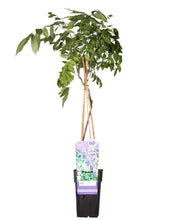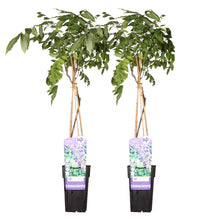Wisteria sinensis 'Prolific', also known as the Chinese wisteria, is a vigorous and beautiful deciduous climber prized for its abundant, fragrant flowers. This cultivar of Wisteria sinensis is known for its prolific flowering, producing masses of long, pendulous racemes (flower clusters) in shades of lilac-blue in late spring and early summer. The flowers have a sweet, heady fragrance that fills the air with a delightful perfume. It's a popular choice for covering walls, fences, pergolas, and arbors, creating a stunning floral display. It belongs to the Fabaceae family (the pea family).
Origin: Wisteria sinensis is native to China. 'Prolific' is a cultivar selected for its exceptional flowering capabilities.
Light: Wisteria sinensis 'Prolific' thrives in full sun. It prefers at least 6-8 hours of direct sunlight per day to encourage optimal flowering.
Water: Water regularly, especially during dry periods and the first year after planting. Wisteria prefers consistently moist soil, but avoid overwatering, which can lead to root rot.
Soil: Wisteria sinensis 'Prolific' prefers fertile, well-drained soil. It can tolerate a range of soil types, but thrives in loamy soil with a slightly acidic to neutral pH.
Support: As a vigorous climber, Wisteria sinensis 'Prolific' needs strong support to grow. Provide a sturdy trellis, pergola, or wires for the vine to climb on.
Pruning: Pruning is essential for maintaining the shape and promoting flowering of your wisteria. Prune twice a year: in summer, shorten the current year's growth to about 5-6 buds from the main branch; in winter, shorten the same shoots again to 2-3 buds. This encourages the formation of flower buds.
Hardiness: Wisteria sinensis 'Prolific' is hardy and can tolerate cold winters.
Uses: This wisteria is primarily grown as an ornamental climber for its stunning floral display and fragrance. It's a popular choice for creating beautiful arches, covering pergolas, and adding a touch of elegance to gardens.
Toxicity: Wisteria sinensis 'Prolific' contains wisterin, a toxic glycoside, in its seeds, pods, and bark. It's best to keep it away from children and pets.



